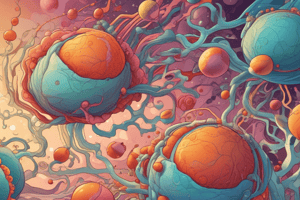Podcast
Questions and Answers
What is the quaternary structure of proteins?
What is the quaternary structure of proteins?
- The primary structure of proteins
- The two-dimensional shape of protein molecules
- The arrangement of multiple folded protein subunits in a multi-subunit complex (correct)
- The three-dimensional shape of protein molecules that bend and twist to achieve maximum stability
What is the tertiary structure of proteins?
What is the tertiary structure of proteins?
- The primary structure of proteins
- The two-dimensional shape of protein molecules
- The arrangement of multiple folded protein subunits in a multi-subunit complex
- The three-dimensional shape of protein molecules that bend and twist to achieve maximum stability (correct)
What stabilizing forces contribute to the tertiary structure of proteins?
What stabilizing forces contribute to the tertiary structure of proteins?
- Van der Waals forces between protein subunits
- Hydrogen bonds between protein chains
- Bonding interactions between the side-chain groups of amino acids (correct)
- Ionic interactions between protein molecules
How are protein subunits held together in the quaternary structure?
How are protein subunits held together in the quaternary structure?
Flashcards are hidden until you start studying
Study Notes
Protein Structure
Tertiary Structure
- Refers to the 3D shape of a single polypeptide chain, including the interactions between side chains and the folding of the chain
- Determined by the sequence of amino acids, hydrophobic interactions, ionic bonds, hydrogen bonds, and disulfide bonds
- Stabilizing forces that contribute to the tertiary structure include:
- Hydrophobic interactions between non-polar amino acids
- Ionic bonds between charged amino acids
- Hydrogen bonds between polar amino acids
- Disulfide bonds between cysteine residues
Quaternary Structure
- Refers to the arrangement of multiple polypeptide chains (subunits) in a protein
- Subunits are held together by:
- Hydrophobic interactions between non-polar amino acids
- Ionic bonds between charged amino acids
- Hydrogen bonds between polar amino acids
- Disulfide bonds between cysteine residues
- The specific arrangement of subunits determines the protein's biological function
Studying That Suits You
Use AI to generate personalized quizzes and flashcards to suit your learning preferences.




